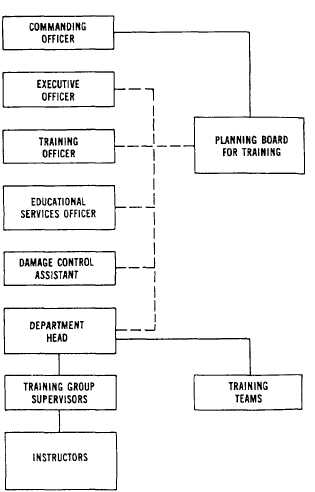group is defined as any group of individuals requiring
similar training. For example, all personnel of a division,
a gun crew, or an engineering watch team or all officers
of the deck would constitute individual groups.
DAMAGE CONTROL TRAINING
Each ship must establish and maintain a trained
damage control training team (DCTT). Whenever
possible, the executive officer should serve as the DCTT
team leader.
The purpose of the DCTT is to train the ship’s
damage control organization to use current fleet damage
control techniques. The DCTT observes and evaluates
all in-port emergency teams, general quarters repair
lockers, and the at-sea fire party. The DCTT may also
evaluate the setting of material conditions, perform
damage control preventive maintenance, and validate
compartment checkoff lists.
DCTT members should be the most qualified and
motivated personnel on board the ship. The
effectiveness of the DCTT is proportional to the level of
command support for a strong qualification program. At
a minimum, DCTT members should be PQS-qualified
in general damage control and in advanced damage
control to at least the level of the watch station the
member is designated to evaluate. They should also have
proven leadership abilities, surface warfare officer
(SWO)/enlisted surface warfare specialist (ESWS)
qualification, and formal damage control schooling.
The ship should establish a DCTT training program
to train replacement personnel. As part of that training,
the program should require those personnel to observe
damage control drills and to become familiar with their
assigned watch station. It should also train them to
critique a main space fire drill. The appropriate levels of
the chain of command should record and review their
training accomplishments as part of the formal
qualification process.
To build confidence in damage control parties, the
training program should simulate actual casualties as
realistically possible. Simulations should be strictly
limited and authorized only for the safety of equipment
and personnel. DCTT members should monitor all
aspects of the exercise and act as safety observers.
Figure 5-2 provides a listing of training devices,
disclosures, and simulations that enhance realism.
Figure 5-3.-Shipboard training organization.
TRAINING ORGANIZATION
The command’s administrative organization should
include provisions for training. Figure 5-3 shows a
typical shipboard training organization.
PLANNING BOARD FOR TRAINING
The planning board for training (PBFT) is the
principal organization through which the command’s
training is formulated and carried out. The board’s
ultimate goal is to produce well-trained and qualified
personnel.
Responsibilities and Function of the PBFT
The PBFT is responsible to the commanding officer
for developing a training program that is compatible
with the command mission. The board will propose
policies, methods, and procedures for executing the
command training program and integrate those ideas
into immediate and long-range training objectives. It
5-11

